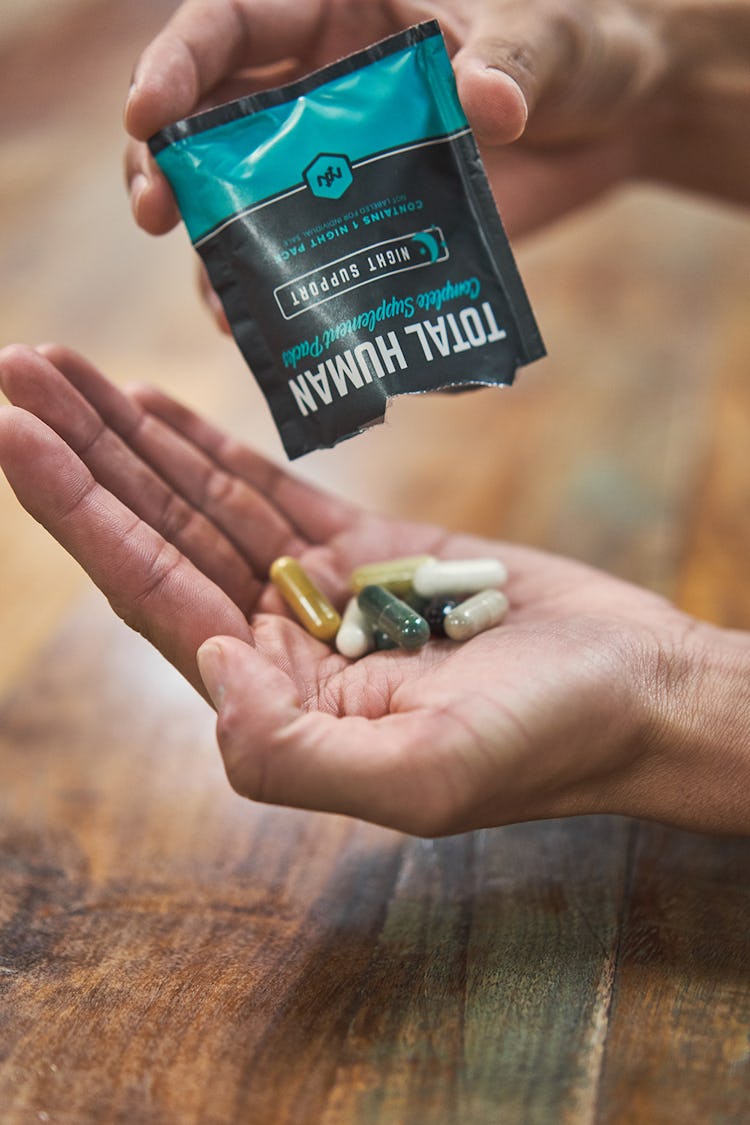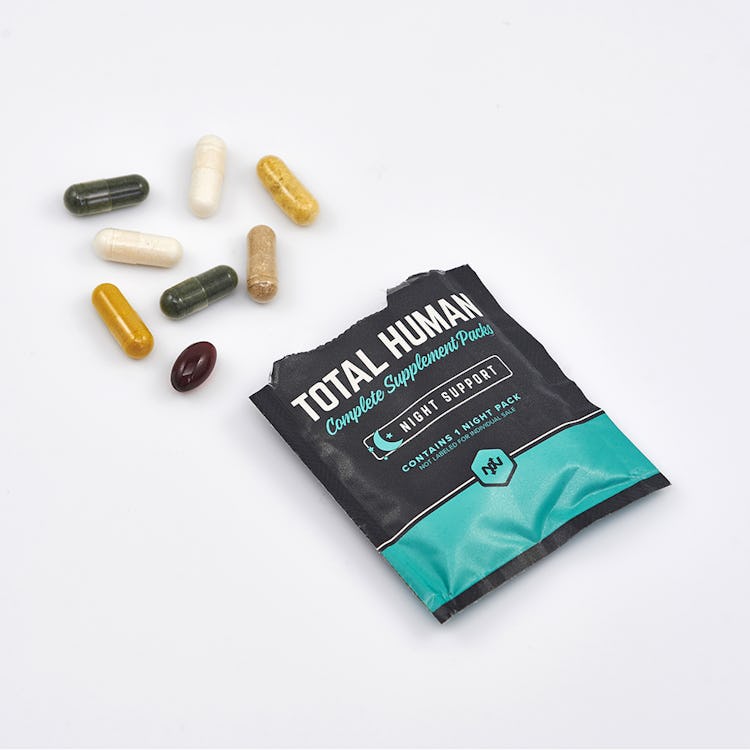We’ve been taught that a multivitamin will fill in the gaps in our diets since mom handed us our first Flintstones™ chewable. The trouble is, like the Flintstones themselves, most vitamin and mineral supplements remain in the proverbial Stone Age. They don’t contain all the nutrients we really need to be optimized, or in the amounts that are necessary to feel a positive difference. That’s why Onnit created Total Human®: an all-in-one pack that combines the most vital components of several of our other products (Alpha BRAIN®, New MOOD®, and more) to offer one mega-supplement for supporting health and performance.
The Ingredients of Total Human Optimization: A Guide To Vitamins
While TPC was an instant success and has been embraced by many professional athletes, we knew we could do even better. We listened to our customers and followed the emerging science on micronutrition. For one thing, we discovered that the spirulina tablets we included in the TPC day pack had a tendency to get crushed in transit, showing up as messy crumbs when users opened the packet. For another, the research showing how widespread vitamin D deficiency is, and how detrimental that can be, was a wake-up call that we needed to pump up the dosage. The CDC reports that 23 million Americans have a “severe” vitamin D deficiency, with African-Americans and Mexican-Americans carrying the highest risk.
In response, we replaced the spirulina tablets with capsules (and changed to a certified organic source). We also upped the vitamin D content by almost four times and, recognizing the importance of getting more B vitamins in the diet, added an entire B complex for its energy- and cognitive-supporting power.†
With all these changes, it was clear that Total Primate Care had evolved into something greater, so we’re now reintroducing it as a new, improved product we call Total Human® (available now). It covers all the micronutrition bases that made TPC a staple in our athletes’ diets, plus the aforementioned additions.
If you haven’t tried our formulas yet, or you’re skeptical about how they can help optimize you, let this guide answer all your questions about vitamins and minerals and other little-known nutrients that can make a huge difference in how you feel, think, and perform.
The Easiest Way To Get Optimized
There’s no shortage of options for vitamins and supplements, but which ones do you need?
Total Human® is a complete re-imagining of the daily multivitamin, combining many of our best-in-class formulas into a simple & effective all-in-one product.
Not simply one pill, Total Human® is a dense, rich dose of a myriad of Earth-grown nutrients and clinically-studied ingredients specifically balanced to support the brain, mood, energy, bones, immune system, joint health, and more.†
These formulas come in convenient day and night packs, each aimed at building you up while you work, and working while you sleep.†
There’s no easier way to get optimized. Click here to Try Total Human® Today.
What’s The Difference Between Vitamins and Minerals?
Vitamins are the micronutrients you get from animal and plant sources. These include A, C, D, E, K, and the various B vitamins. Minerals come from soil and water and include calcium, iron, magnesium, potassium, and many others. Both vitamins and minerals are essential to good health and athletic performance.
There are two types of vitamins: fat-soluble and water-soluble. Fat-soluble vitamins, including A, D, E, and K, dissolve in fat. That means that they’ll be soaked up by your fat cells and stored when you consume them. Water-soluble vitamins (the B vitamins and vitamin C) need to dissolve in water before your body can absorb them. They can’t be stored, and, as a result, you need to consume more of them. In a similar way, your body needs more of some types of minerals than it does others. Its demand for calcium is high, while copper, iodine, selenium, and zinc, for example, are known as trace minerals because you only need small amounts daily.
What Do Vitamins and Minerals Do?
Both types of nutrients play multiple roles in supporting growth and development and helping the body’s cells function properly. Here’s a quick (and only partial) rundown of what the most popular vitamins and minerals do.
Vitamin A. An essential component of a protein that absorbs light in the retina, it’s crucial for vision.
B vitamins. There are eight of them in all, including thiamine, riboflavin, niacin, and folate. B vitamins promote energy and help support memory, skin health, and a positive mood. A study in Human Psychopharmacology found that taking B vitamins significantly decreased subjects’ feelings of stress in the workplace after 90 days, causing the researchers to suggest Bs as a cost-effective treatment for job-related strain.
Vitamin C. Necessary for protein metabolism and the creation of collagen, C is a major factor in healing wounds. An antioxidant, it fights free radicals and helps regenerate other antioxidants within the body.
Vitamin D. Helps promote immune and heart health as well as regulate mood. D also increases the body’s ability to utilize other minerals, such as calcium.
Vitamin E. A powerful antioxidant, it helps with immune function and metabolism.
Vitamin K. Helps regulate blood clotting, so wounds stop bleeding and can begin to heal.
Calcium. You already know it helps fortify bones and teeth, but calcium also lets your muscles contract and aids in the secretion of hormones like insulin.
Iron. Helps red blood cells carry oxygen around the body, supporting energy levels.
Magnesium. More than 300 different metabolic reactions depend on magnesium, including the body’s ability to burn carbs and fat for energy. Similar to calcium, it can promote bone mineral density.
Phosphorus. Every cell in the body needs phosphorus to function. It helps filter waste out of the kidneys and manages energy.
Potassium. Helps maintain fluid balance in the blood and muscles; supports muscle, heart, and nervous system functions.
Zinc. Your sense of taste and smell rely on it.
Can’t I Get The Nutrients I Need Through Food?
Eating a balanced diet with animal foods, vegetables, fruits, and whole grains will supply the lion’s share of vitamins and minerals you need. For this reason, some pundits have argued that multivitamins are a waste of money. Eat well, they say, and your micronutrient requirements are covered.
The trouble is, however, that most people don’t eat well. Especially kids, and their poor eating habits can not only make them perform worse in school but also be more disruptive. A California State University study supplied a group of schoolchildren with a multivitamin supplement and tracked their behavior for four months. Ultimately, the kids’ whose diets were bolstered by the extra vitamins and minerals exhibited less “antisocial behavior”—that is, less fighting, cursing, vandalism, and other offensive conduct.†
And how about multivitamins helping them think better too? The Journal of Alternative and Complementary Medicine revealed that supplementation could dramatically raise “the non-verbal intelligence” of some school kids, “presumably because they were too poorly nourished before supplementation for optimal brain function.”†
While it’s true that major vitamin and mineral deficiencies (to the point where diseases result) are hard to come by in developed nations like the U.S., recent research indicates that the vast majority of us still aren’t getting enough of what we need. A 2016 article in the Journal of Family Practice states that more than 90% of Americans don’t get adequate amounts of at least one vitamin or mineral in their diets. This can be due to lack of access to certain foods or avoidance of such foods for cultural reasons. As a result, the U.S. Departments of Health and Human Services and of Agriculture note that dietary supplements “may be useful in providing one or more nutrients that otherwise may be consumed in less than recommended amounts or that are of particular concern for specific population groups.”
Furthermore, a study in the Journal of the American College of Nutrition showed that, when subjects combined a good diet with a multivitamin, they were more likely to meet their minimum vitamin and mineral requirements.
Nevertheless, there’s a persistent myth that multivitamins don’t get absorbed—you just pee them right out. First of all, this could only be true of water-soluble vitamins, not those that are stored in fat. Secondly, pissing out good nutrition will only happen when your body senses an excess of vitamins and minerals. Unless you have some serious gut health issues that prevent absorption, your body will take in most of what you consume if you need it—food or supplement. “Multi-vitamins work as a great catch-all,” says Carla Nowicki, R.D., an Austin, Texas-based dietitian and owner of Pursuit Nutrition. “It is hard to track all the trace amounts that each individual needs, so a multi-vitamin will make sure you are covered.”
Which vitamins and minerals am I not getting enough of?
Research consistently shows that Americans have trouble meeting their requirements for the following.
B vitamins. According to the Centers for Disease Control (CDC), 30 million Americans have a B6 deficiency, and African Americans are at a particularly high risk. Furthermore, data from Tufts University shows that 40% of people aged 26 to 83 have B12 levels that are on the low end of normal—bad enough that they may exhibit lack of focus. Aside from assisting with feelings of alertness, B12 is thought to protect the sheaths that cover nerves.† So failing to maintain B12 levels is like neglecting to maintain electrical wires—they’ll fray, and the signals they carry won’t get relayed efficiently.
If you follow a plant-based diet, you’ll almost certainly need to supplement with B vitamins, as they’re not available outside of animal foods. A review of 40 studies in the European Journal of Clinical Nutrition found that as much as 86.5% of vegetarians—and even more vegans—were at risk for B vitamin deficiency.
Calcium. Studies show that teenagers tend to replace milk in their diets with soda, leading to a lower calcium intake that can hinder their overall development. As for grownups, the National Health and Nutrition Examination Survey (NHANES) indicates that the average dietary calcium intake for both men and women is likely several hundred milligrams below the Recommended Dietary Allowance (RDA).
Vitamin D. Yes, your body can make its own when you’re exposed to sunlight, but it’s not as easy as a day at the beach. Atmospheric conditions (like cloudy days) and geographical location can filter out much of the sun’s rays—not to mention any clothing or sunblock you wear. This is one vitamin where it seems better to err on the side of more rather than less. A 2014 study from the University of Alberta concluded that the current Recommended Dietary Allowance (RDA) for vitamin D, 600IUs daily, was not enough to support bone and immune health. Researchers go on to suggest that more than 10 times that amount may be necessary to provide the benefits that D is touted for.
Iodine. In 2012, the journal Paediatric and Perinatal Epidemiology reported that iodine requirements increase 50% during pregnancy. Failure to take in more can actually cause a woman’s baby to be born dumber. Say the paper’s authors: “Two meta-analyses have estimated that iodine-deficient populations experience a mean reduction in IQ of 12–13.5 points.” Meanwhile, the CDC says that one-third of pregnant women in the U.S. are borderline iodine deficient. In addition, according to the Linus Pauling Institute, a non-profit research center at Oregon State University, iodine intake has been decreasing in recent years.
Iron. Females are again at the greatest risk. The CDC claims 7.5 million women ages 12 to 49 have low iron (African- and Mexican-Americans are again the most susceptible among them).
Magnesium. In developed nations, deficiency of magnesium is more common than a deficiency of any other vitamin or mineral, with the exception of vitamin D. Though the RDA is 400–420mg/day for men and 310–320mg/day for women, NHANES found that Americans’ average magnesium intake is much lower—350mg for men and 260mg for women. Older people (age 50+) exhibited even worse numbers.
The problem is how Americans eat. The National Institutes of Health (NIH) states that “The diets of most people in the United States provide less than the recommended amounts of magnesium.” People fill up on grains, and while bran flakes and other cereals come up on lists of foods that are magnesium-rich, the magnesium they offer is poorly absorbed by the body.
According to the NIH, other health factors can drain your magnesium levels as well, such as gastrointestinal problems or being very overweight. Low magnesium can exacerbate these troubles further, as too little magnesium is bad for blood pressure and insulin sensitivity.
One of the main reasons otherwise healthy people can come up short on certain vitamins and minerals is because of activity levels. People who weight train and play sports burn through nutrition more quickly than sedentary people do, so if that sounds like you, it’s likely that your micronutrition needs aren’t being completely met, even by your healthy diet. The government’s 2015 Dietary Guidelines for Americans suggest that dairy, fruit, and vegetable intake is suboptimal among the populace, and that athletes in particular may be under-consuming vitamins A and C, along with calcium, iron, and zinc.
Is It Dangerous to Take Vitamins and Minerals?
Scientists have established upper limits for micronutrients, and consuming greater amounts has been shown to have adverse effects, but mainly in special populations. According to the National Institutes of Health, smokers should avoid multivitamins that provide a large amount of vitamin A or beta-carotene, as they may increase the risk of lung cancer (remember, this is in people who already smoke cigarettes). Additionally, pregnant adult women who exceed the 10,000 IU/day upper limit for vitamin A may put their babies at increased risk for birth defects.
In 2017, there was a scare over B vitamins and lung cancer when Ohio State University claimed a link between B6 and B12 and an increased risk for the disease. Again, as with the vitamin A report, the subjects were smokers, between the ages of 50 and 76, and taking huge amounts—20mg of B6 and 55 micrograms of B12 (the RDA is only 1.3mg and 2.4 micrograms, respectively). Interestingly, the risk of cancer was not found to increase among the women studied.
The study’s head researcher, Theodore Brasky, summed up the findings by saying, “If they are men and they are smoking and taking B vitamin supplements, they really need to quit smoking. Smoking is the number one cause of lung cancer.” It’s also worth noting that a study by the International Agency for Research on Cancer (IARC) found that people—including smokers—who had high levels of B6 and the amino acid methionine in their blood for five years were at a 60% less risk of getting lung cancer. Methionine is common in lean meats such as chicken breast.
Finally, excessive iron (greater than 20mg per kilogram of body weight) has proved to be problematic, leading to stomach trouble, especially if taken without food. It can also interfere with zinc absorption.
Taking medication can also change your tolerance for certain vitamins and minerals, so if you’re on drugs, speak with your doctor before adding any supplements to your diet.
But a greater health concern than getting too much of a micronutrient (or even too little) may be where that micronutrient came from. To save on costs, many multivitamin sellers source their products from China, where pollution is a major public health problem. As The Epoch Times reported in 2014, “Vitamins and nutritional supplements usually use agricultural products as key raw materials. The top vitamin exporting province, Zhejiang, has an alarming level of soil pollution from heavy metal. As matter of fact, one-sixth of China’s farmlands are heavily polluted.” To make matters worse, only two percent of imported vitamin supplements are inspected.
The best way to ensure that you get a safe, quality multivitamin is to choose one that has been third-party tested. “That’s the only guarantee that what the label says is in the bottle is actually what you’re getting,” and that the ingredients are pure, says Shannon Ehrhardt, R.D., a performance dietitian with EXOS (Onnit’s partner in performance nutrition).
Products that bear the NSF or USP seal have been manufactured in a GMP (Good Manufacturing Practices) facility. If you’re a college or pro athlete, you should supplement with products that have also been deemed free of any banned substances—the type that can ruin a career if they turn up on a drug test. “NSF Certified for Sport, Banned Substance Control Group (BSCG), and Informed Choice are three companies that have a respected reputation in this part of the supplement world,” says Ehrhardt. “I won’t even give something as simple as B vitamins or vitamin C to my athletes unless it has one of those three stamps of approval.”
Does the Type of Vitamin Matter?
Not all vitamins are created equal. Your body will absorb some forms better than others. A study in the International Journal of Clinical Pharmacology found that benfotiamine—a type of B1—assimilated best inside the body, peaking B1 levels five times more than other B derivatives, and its bioavailability was more than 3.5 times greater.† In general, you’ll also want your multi to include B vitamins that are methylated. A 2013 review showed that methylated folate (B9), which is how folate appears in nature, is more readily absorbed. And when it comes to vitamin D, the D3 vitamin is the best choice, as it’s the same kind your skin synthesizes with sunlight.
The delivery mechanism you choose for your multivitamin also affects its potency. These days the options range from capsules and tablets that you swallow to tabs you can chew and liquid shots that you drink. Capsules typically absorb well, have a long shelf life, and contain the greatest amounts of the nutrition they purport to. Tablets are usually a good option too, but they can break during travel, leaving a messy powder that makes consumption more difficult. According to Carla Nowicki, there’s a simple at-home test you can put your tablets through to see if they work well: drop them in water. They should dissolve in eight hours. “If they don’t dissolve and they sink to the bottom of your glass,” says Nowicki, “they probably won’t be absorbed as easily.”
Chewable tablets and liquid vitamin cocktails may taste good, but the extra ingredients manufacturers need to add to make them palatable (sugar, artificial flavorings) dilutes the amount of micronutrition that can go into them. These products typically won’t include chromium, magnesium, selenium, or zinc either, as their flavors are hard to mask.
Gummy vitamins can be alluring because they seem like candy, and they basically are. (Nature Made Gummy Vitamin C contains two grams of sugar per serving.) But according to ConsumerLab.com, a group that conducts independent testing of consumer health products, most gummies simply can’t be trusted. In tests conducted on 50 different multivitamins, 80% of the gummies did not meet dietary supplement standards. Furthermore, 12 of the products contained as little as 24% of the micronutrients that were advertised, and, simultaneously, a frightening 157% more than promised.
When Should I Take a Multivitamin?
Some vitamins and minerals benefit you more at one time than at another. For instance, you should take calcium before bed. The Journal of the Medical Association of Thailand showed that supplementation with calcium before bed helped reduce markers of bone loss compared to supplementation at breakfast.† To help with sleep itself, magnesium can be helpful. A 2012 study showed that, taken before bed, it helped increase sleep time and efficiency.†
B vitamins, on the other hand, will be most beneficial during the day. “They help convert the carbs and fat you eat into energy,” says Shannon Ehrhardt, so take them before or with a meal. In general, because vitamins A, D, E, and K are fat-soluble, you’ll get better absorption of them if you take them with a fat-rich meal.
There are also less than ideal times to take certain micronutrients. Calcium can compete for absorption with strontium—another bone-friendly mineral—so it’s best to take those separately. The same goes for calcium and iron, says Ehrhardt.
What Else Do I Need To Be Optimized?
A good multivitamin will cover the most essential micronutrients you need to feel and perform at your best, but there are a handful of compounds that most brands don’t include that we like to take along with multis for extra credit. Below are our favorites.
Ashwagandha. A review in the Journal of Biological Sciences concluded that this diverse Indian herb may assist with endurance, immune function, mood, memory, and stress relief.†
Astralagus. This Chinese herb, popular in traditional therapies, supports immune health and regulating inflammatory responses.†
Chaga. A 2015 study indicates that this mushroom may help support a strong immune system.†
Cordyceps. Another mushroom, cordyceps was shown in a 2016 study to increase time to exhaustion in cyclists (by about 28 seconds).† It also seems to promote normal immune function.†
Krill oil. Virtually everyone is aware that fish oil is beneficial, but krill oil may be the better investment. The journal Lipids found that considerably smaller doses of krill oil had the same positive effect on cellular health, while a 2013 trial discovered that it boosted omega-3 fats to a greater degree.†
Strontium. Calcium gets all the glory for bone health but strontium deserves credit too. Though it’s a mineral like calcium, most multis don’t include it. If you’re an older individual, or you participate in high-impact sports, you may want to make a point of including strontium. The New England Journal of Medicine showed that strontium supplementation demonstrated a remarkable decrease in bone damage risk—41% after three years.†
The Better Than a Multivitamin
Most “all-in-one” supplements just don’t cut it. They aren’t targeting specific systems, and the inclusion of vitamins and minerals are often at bare minimum levels. There is not one single “magic pill” you can take that could possibly provide your body with optimum support, and if recommended daily allowances were all you needed, most everyone would be thriving. That is part of why recent reports have come out saying “multivitamins don’t work.”
That’s also why Total Human® was created to be a rich collection of high-quality nutrients, each purpose-driven to provide a tide of benefits to support your body, mind, joint health, immune system, energy, mood, and other aspects of your well-being.†
Further Reading:
B Ready: How B Vitamins Can Optimize You
Mineral Deficiency: The 5 Missing Minerals In Your Diet
Strontium: The Forgotten Mineral For Strong Bones









)






